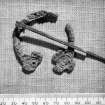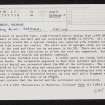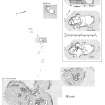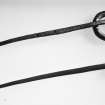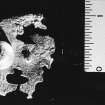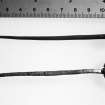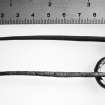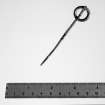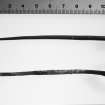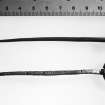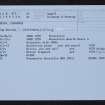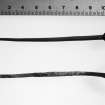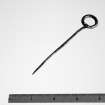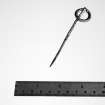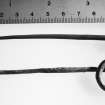Colonsay, Machrins
Burial (Viking)(Possible), Long Cist (Early Medieval), Settlement (Early Medieval), Animal Remains (Iron)(Early Medieval), Knife(S) (Early Medieval), Saddle Quern (Early Medieval)
Site Name Colonsay, Machrins
Classification Burial (Viking)(Possible), Long Cist (Early Medieval), Settlement (Early Medieval), Animal Remains (Iron)(Early Medieval), Knife(S) (Early Medieval), Saddle Quern (Early Medieval)
Canmore ID 37923
Site Number NR39SE 47
NGR NR 3579 9330
Datum OSGB36 - NGR
Permalink http://canmore.org.uk/site/37923
- Council Argyll And Bute
- Parish Colonsay And Oronsay
- Former Region Strathclyde
- Former District Argyll And Bute
- Former County Argyll
Excavation (1977 - 1978)
NR39SE 47 3579 9330.
A settlement of possibly four, single-roomed houses dating from c.800 AD was noted in machair at Cnoc nan Gall and was excavated by RCAHMS in 1977-8. All the houses were severely eroded but a typical example was squarish with rounded corners and measured 4.2m across the centre. The walls were of upright slabs set in a shallow groove in the sand and there was an entrance in the NE. There was no outer wall-face nor was there any indication as to how the roof was supported. Internally there was a central hearth and probable cupboard. Excavation finds included iron knives. A saddle quern was found, built into an external bench.
The occupation appeared to have been sporadic and possibly seasonal. A long-cist burial was excavated about 14m ESE of the settlement. The cist measured 1.6m NE-SW by 0.7 by 0.3m deep and contained the remains of a flexed inhumation which had been accompanied by a dog and grave-goods including pin with a loose ring-head, a fragment of decorated bronze, an iron nail and a fragment of textile. The bones produced a C14 date of AD 780 +/- 70. It is not certain that the burial and the settlement were associated.
J N G Ritchie 1982
Field Visit (June 1978)
In 1977 erosion of the machair 1 km w of Machrins exposed traces of a small settlement; subsequent excavation revealed four houses and a single long-cist burial, and the following account is a summary of the published report (Ritchie 1982). The houses had been considerably disturbed both by erosion and by rabbit burrows, but the best-preserved (No. 2 on Fig.) was squarish on plan with rounded corners and measured about 4·2 m across the centre. The walls survived merely as a series of upright slabs dug into the sand, and it is clear from their slight nature that the main part of the building was of timber or turf. Among the best-preserved features, however, were the stone-lined hearths within houses 2 and 4.The small finds included single-sided iron knives, bone pins or needles, a saddle quem and pebble pounders or weights. The animal remains included bones of cattle, sheep, pig and roe-deer. Analysis of the bones from house 2 provided a radiocarbon date of ad 800±70 (Gu- 1115) for the period of use of the site.
The long-cist burial lay some 14 m ESE of the settlement; aligned NE and sw and measuring 1·6 m by 0·7 m and 0·3 m in depth, it contained the remains of a flexed inhumation. As the result of previous disturbance, the upper part of the body, at the sw end of the cist, had not survived, but the leg bones were intact, their position indicating that the body had been buried on its side with its back on the NW side of the grave. A small dog had been laid in the grave with its head at the knees of the inhumation. The accompanying grave-goods included a pin with a loose ring-head, a fragment of decorated bronze, fragments of an iron knife and an iron nail. A radiocarbon date of ad 780 ± 70 (Gu- 1114) was obtained from analysis of the long bones of the inhumation.
The small finds associated with the burial suggest that it is Viking, but the plan-form of the houses is perhaps more likely to indicate a native tradition.
RCAHMS 1984, visited June 1978

























